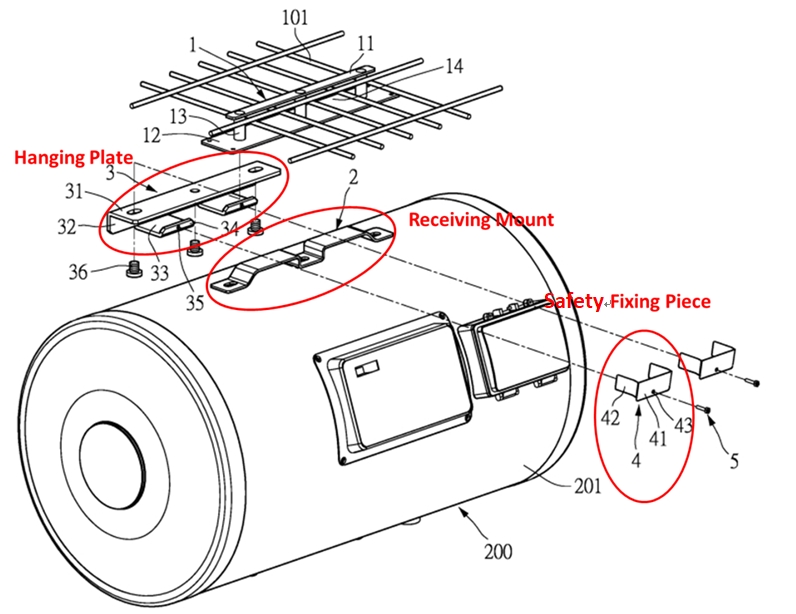Taiwan Sakura v. IP Office:
Court Revisits TIPO’s Claim Interpretation
A Taiwanese patent for the anti-shake hanging structure of a water heater was invalidated by the Taiwan IP Office (“TIPO”). TIPO’s decision was appealed to the Intellectual Property and Commercial Court’s (“IPCC”) administrative tribunal and was overturned on December 15, 2021.
Claim 1 and other claims were determined invalid due to a finding of no inventiveness. Claim 1 has an element reading “a safety fixing piece inserted between a hanging plate and a receiving mount (see Fig. 1).” The prior art evidence demonstrated that a stopping rod penetratingly fixes onto two hanging members to prevent them from relative slippage. TIPO argued that from the text of the claim, the safety fixing piece is not specifically defined in terms of its structure and the particular technical feature of its engagement with the hanging plate and the receiving mount. In accordance with the principle of prohibiting the importing of limitations from specifications into a claim, it would not be appropriate to incorporate the details of the mechanical structure (namely, two side plates plus a reverse U-shaped plate at the front) from the specification into Claim 1. TIPO could only construe the technical feature of Claim 1 according to its broadest reasonable interpretation—on the literal wording “inserted between.” As such, TIPO found that the mechanism of fixation followed by penetration in the prior art evidence was a variant of insertion as featured in Claim 1. Thus, Claim 1 was not inventive over the prior art evidence in view of ordinary skill in the art.
One of the inquiries presented before the court was as follows: in the claim construction, does the prohibiting the importing of limitations from specifications into a claim mean to overlook the specification and drawings?
The answer to this was no; the court held that when construing a claim, prohibiting the importation of a limitation from the specification does not excessively mean disregarding the specification and drawings.
The scope of claims of a patent is defined by the claims while the description and drawings may be considered as a reference when interpreting the claims (§58(4) of the Patent Act). As is the long-established local practice, the claimed scope shall be determined upon the “broadest reasonable construction that is consistent with the description.” When the description manifestly expresses the definition and meaning for a particular term in the claims, said definition and meaning must be taken into account. When an ambiguity arises in the process of construing a claim, one shall consult the description in the specification, drawings, and the general knowledge at time of filing.
On the other hand, it is also required that the limitation in the specification cannot be read into the claim. Such a non-statutory prohibition is another well-established practice for ensuring that the claimed scope is not unduly narrowed. However, it cannot be overly interpreted as turning a blind eye to the specification and drawings and defining the claimed scope solely by the text and words in a claim. Instead, efforts should be made to confirm whether a claim interpretation is improper through the interplay of broadening and narrowing to achieve the objective and reasonable purpose.
Upon investigation of the description in the specification, it was clearly expressed that the insertion of the safety fixing piece would serve to fill the gap between the hanging plate and the receiving mount, and would help to stabilize the heater’s body, thus preventing it from shaking. These technical functions, methods and results should be taken into account when construing Claim 1. In contrast to the insertion of the safety fixing piece in Claim 1, other prior art in the evidence disclosed the method of fixation of a stopping rod—fixed between and penetrating two hanging members—which does not have the function of filling a gap, and therefore does not serve the purpose of stabilizing the heater’s body. In view of the above, TIPO determined erroneously that the technical feature of Claim 1 was a variant of penetrating fixation achieved by a stopping rod as disclosed by the prior art evidence.
For these and other reasons, the court vacated TIPO’s decision.
The court emphasized that the “broadest reasonable interpretation consistent with the description” was not only the broadest possible scope but was supposed to be reasonable and consistent with the description. More importantly, prohibiting the incorporation of matters from the description into the claims did not amount to a rigid refusal of anything from the description. It is the inherent purpose of the description to help claim construction and to offer text support. The purpose is to reach a reasonably defined scope which lies at the equilibrium of expansion and restriction.

Fig. 1 Exploded view showing how a safety fixing piece can be inserted between the hanging plate and the receiving mount.
|